Posts by Chris Bowditch
80 years on from El Alamein: The battle we simply had to win…
“Before Alamein we never had a victory. After we never had a defeat.”
Winston Churchill
It’s 1942 and the fortunes of war are running against the Allies on almost every front.
In the east, the Soviets are in collapse.
In the Atlantic, U-boats are crippling the ferrying-in of Britain’s vital supplies.
While, in western Europe, Nazi troops are the occupying force in country after country.
To North Africa, where Rommel’s Afrika Korps are trying to break through to the Suez Canal – and to that all important oil of the Middle East.
To stop them, the Egyptian village of El Alamein, situated between the Mediterranean Sea and the Qattara Depression, simply had to be held.
The defending Allies were represented by the Eighth Army – the ‘Desert Rats’, led by General Montgomery.
Montgomery had a plan. He would launch a diversionary attack to the south, while the main attack would come from the north, nearer to the coast.
And 80 years ago, on the night of 23-24 October 1942, the attack began.
A noise so great, the gunners’ ears bled
It started with the firing of over 800 artillery pieces at the German lines, creating a noise so great that, according to legend, the ears of the gunners bled.
When the infantry attacked, they were followed by tanks that moved through the minefield along a path cleared by engineers.
Outnumbered and under constant attack from land and air forces, on November 4th, Rommel, refusing to carry out Hitler’s suicidal order to fight to the last, retreated.
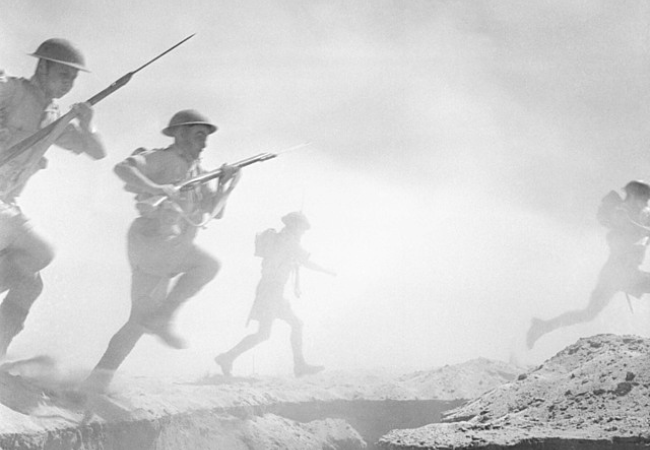
Image Credit: Chetwyn (Sgt), No 1 Army Film & Photographic Unit.
The Battle of El Alamein, fought in the deserts of North Africa with tank warfare at the heart of it, was undoubtedly one of the pivotal battles of World War II.
The battle revived the morale of the Allies and helped turn the tide during the war. As Churchill noted, “After Alamein we never had a defeat”.
The Battle of El Alamein NumisProof
A Silver Proof NumisProof Commemorative has been issued to mark the 80th Anniversary of the battle of El Alamein.
This stunning NumisProof has been struck from Sterling Silver to a perfect Proof finish, it features a full colour design created by world renowned digital artist Adam Tooby.
It depicts the two leading military commanders involved in the battle – Britain’s Bernard Montgomery and Germany’s Erwin Rommel, with the battle raging in the background.
For such an important anniversary of such an important WWII battle, you’ll be surprised by the edition limit. Just 250 have been authorised.
Today I invite you to be one of just 250 people in the world to own this scarce 80th anniversary commemorative.
Click here to own the 80th Anniversary of the Battle of El Alamein NumisProof >>
The Story of the Falklands Conflict – told through a Brand New Set of Commemoratives
For many it’s hard to believe that it’s been 40 years since the Falklands conflict took place.
It’s a conflict our nation remembers only too well. It was one of the first military endeavours that had been televised, with daily reports being broadcast to our screens, reports of heroic fighting and of course, sadly, casualties.
Indeed, it’s to all those that served our country in the Falklands that we’re proud to dedicate a superb set of new commemoratives – issued for the 40th anniversary.
I’d like to talk you through each of the designs, and in doing so tell the story of the Falklands conflict…
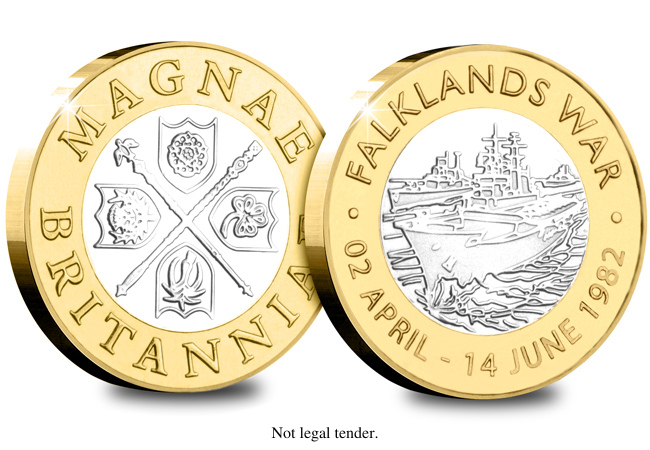
Our battleships crossing the Atlantic
In a move condemned by the United Nations, in 1976 Argentinian forces occupied the Falkland Islands and South Georgia. In the weeks that followed, islanders were forcibly deported.
In response, for the first time since the Second World War, all branches of the British armed forces were deployed and within days a British task force set sail across the Atlantic.
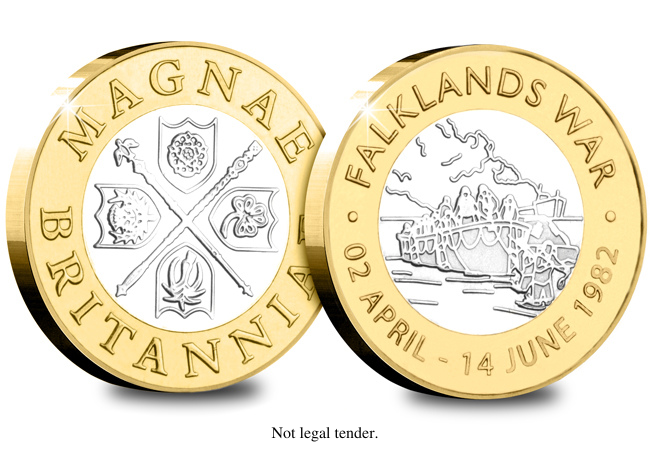
Troops landing on the Falkland Islands
The Task Force landed 4,000 troops in the East Falklands. Goose Green was the first settlement to be taken by British forces. British troops then face a difficult journey through tough terrain, enemy minefields, and hostile weather conditions.
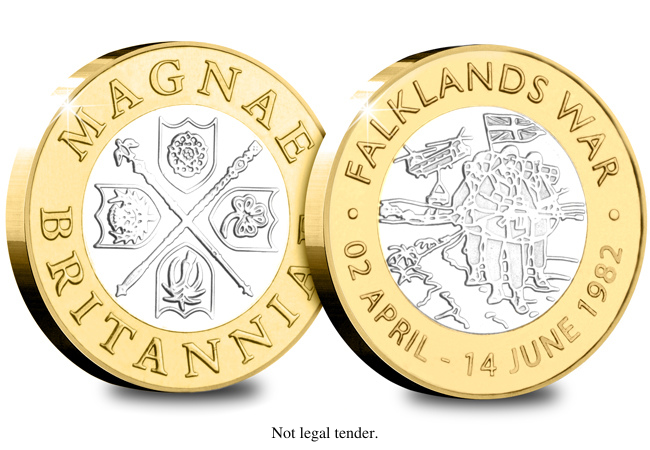
British troops ‘yomping’ across difficult terrain on the Islands
The design of this commemorative pays homage to one of the most famous images from the conflict, taken by Royal Marines photographer Peter Holdgate, showing a Corporal with a Union flag fixed to his pack.
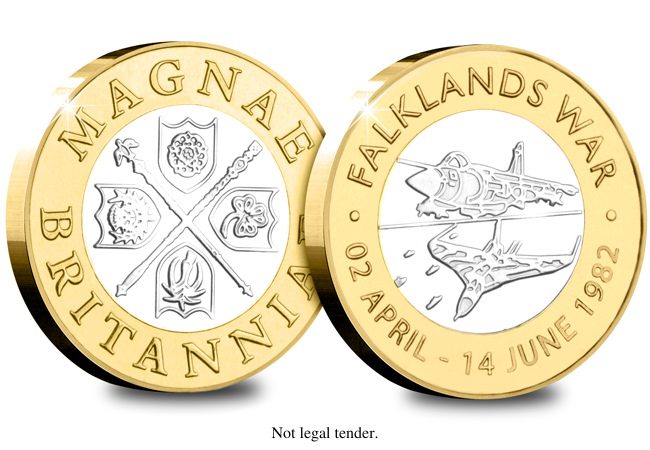
British aircraft patrolling the skies
British aircraft played a key role in the conflict, most famously with the Harrier jets and the Vulcan bomber – two planes that are still strong in British consciousness because of their important role in defending the Falklands.
Although at the start of the conflict Argentina seemed to have an advantage in the air with over 100 aircraft of varying types, it was the strategy of the British Air Force that meant the British pilots were able to beat the odds and take control of the skies.
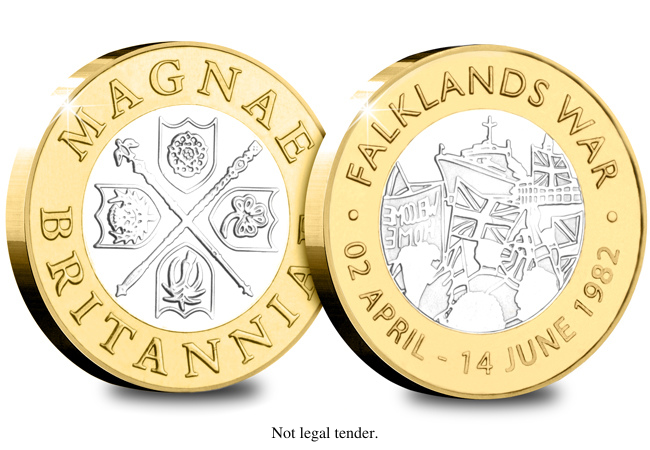
Returning to a Hero’s welcome
British troops were eventually able to make their way home, with huge crowds gathering in Portsmouth and Southampton to welcome them back – a well deserved hero’s welcome on their return.
This BRAND NEW set of commemoratives tells the story of the conflict and comes complete in a presentation pack to display and store them for years to come. I hope that you agree that it’s a perfect tribute to this important moment in British military history.
Did you serve in the Falklands or have memories of family or friends that were involved? As part of our remembering of the conflict 40 years since the invasion, we’d love to hear your stories in the comments below.
If you’re interested…

Click here to view the full range of Falklands War Commemoratives >>
RELEASED TODAY: Don’t miss out on these Precious Metal Platinum Jubilee 50ps…
There’s no doubt that Her Majesty’s Platinum Jubilee is going to be the most collectable Royal theme for many years to come…
And today, a BRAND NEW range of Precious Metal 50p coins have been released to mark this once in a lifetime event.
With tiny edition limits across the range, collectors will be rushing to secure these brand new issues. With the standout being the WORLD’S FIRST Double Diameter Gold Proof 1oz 50p Coin!
Never before have collectors seen this, which is why this issue is sure to be in extremely high demand…
Just watch the video below to find out everything you need to know about these brand new releases…
If you’re interested…
Click here to view the full range of Platinum Jubilee Precious Metal 50ps >>


